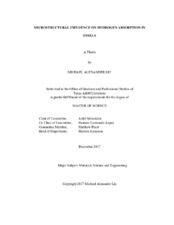| dc.contributor.advisor | Srivastava, Ankit | |
| dc.contributor.advisor | Castaneda, Homero | |
| dc.creator | Liu, Michael Alexander | |
| dc.date.accessioned | 2019-01-16T21:21:42Z | |
| dc.date.available | 2019-12-01T06:34:22Z | |
| dc.date.created | 2017-12 | |
| dc.date.issued | 2017-12-04 | |
| dc.date.submitted | December 2017 | |
| dc.identifier.uri | https://hdl.handle.net/1969.1/173233 | |
| dc.description.abstract | The presence of hydrogen in structural metals and alloys especially steels has
proven to be a problem warranting a significant amount of attention for over a century. In
steels presence of hydrogen severely degrades its mechanical properties such as ductility
and fracture toughness, commonly known as hydrogen embrittlement. Hydrogen can be
introduced into materials during processing or in-service application under aggressive
environments. Hydrogen embrittlement is of particular concern under hydrogen rich
aqueous environments. Electrochemical charging environments have been shown to have
a more deleterious effect on mechanical properties of steels than gaseous environments.
For a given environment the ingress of hydrogen into a material is also influenced by its
microstructural features. Following this, in this thesis, a comprehensive analyses of the
effect of microstructural features on hydrogen absorption in steels have been carried. The
focus is confined to pure iron, AISI 1018 low-carbon steel and AISI 4340 high strength
alloy steel. The hydrogen is introduced into cylindrical billets of the three materials
through electrochemical charging. The total hydrogen content of the charged billets are
then quantified following gas fusion analysis principle commonly termed as melt
extraction. This allows the quantification of absorbed hydrogen in a given material as a
function of charging time. The results reveal that hydrogen content in pure iron increases
with charging time and tends to saturate. On the other hand in 1018 and 4340 following
initial saturation, the hydrogen content tends to increase again with continued charging.
The mechanical properties of the hydrogen charged billets of the three materials are also
characterized using nanoindentation technique. Lastly, thermo-kinetic modeling of
hydrogen absorption in these materials has been carried out. The modeling results aid in
better understating the correlations between hydrogen absorption and microstructural
trapping sites present in these materials. | en |
| dc.format.mimetype | application/pdf | |
| dc.language.iso | en | |
| dc.subject | hydrogen embrittlement | en |
| dc.subject | steel | en |
| dc.subject | pure iron | en |
| dc.subject | hydrogen charging | en |
| dc.subject | materials science and engineering | en |
| dc.subject | nanoindentation | en |
| dc.subject | thermodynamic modeling | en |
| dc.subject | G8 Galileo | en |
| dc.subject | hardness | en |
| dc.subject | reduced modulus | en |
| dc.subject | hydrogen diffusion | en |
| dc.subject | corrosion | en |
| dc.title | Microstructural Influence on Hydrogen Absorption in Steels | en |
| dc.type | Thesis | en |
| thesis.degree.department | Materials Science and Engineering | en |
| thesis.degree.discipline | Materials Science and Engineering | en |
| thesis.degree.grantor | Texas A & M University | en |
| thesis.degree.name | Master of Science | en |
| thesis.degree.level | Masters | en |
| dc.contributor.committeeMember | Pharr, Matthew | |
| dc.type.material | text | en |
| dc.date.updated | 2019-01-16T21:21:42Z | |
| local.embargo.terms | 2019-12-01 | |
| local.etdauthor.orcid | 0000-0002-0318-519X | |


